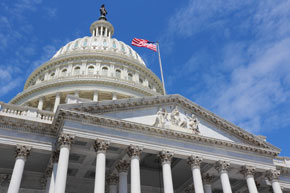Fiscal Costs of the Great Recession

In an effort to stimulate the U.S. economy during the financial crisis and Great Recession, the government increased discretionary spending. Programs that supported the financial sector accounted for most of this fiscal outflow, according to a recent Economic Synopses essay.
Increase in Federal Debt
Economist Miguel Faria-e-Castro noted that the U.S. federal debt and fiscal deficit rose to record peacetime levels as a result of the financial crisis and Great Recession. In particular, he noted, the ratio of federal debt to GDP rose from about 62 percent in 2007 to more than 100 percent in 2013.
The figure below shows the U.S. federal debt and fiscal deficit, both as a percentage of GDP.
Automatic Stabilizers vs. Discretionary Spending
Faria-e-Castro explained that changes in the federal deficit can be broken down into two types of policies:
- Automatic stabilizers, which are government policies that fluctuate automatically with the business cycle (e.g., increased spending on unemployment benefits during recessions)
- Discretionary spending, which Congress sets to fund departments (e.g., defense and education), agencies (e.g., NASA and the EPA) and other programs
He noted that automatic stabilizers make up three-quarters of total federal spending, while discretionary spending makes up one-quarter of total spending before interest payments.
However, from 2009-13, discretionary spending accounted for a higher fraction of the increase in the fiscal deficit. “The Congressional Budget Office has estimated that automatic stabilizers accounted for less than one-third of the increase in the fiscal deficit during 2009-13,” Faria-e-Castro wrote, “implying that discretionary spending accounted for the bulk of that increase.”
Discretionary Spending during the Great Recession
Faria-e-Castro noted that Congress enacted legislation to increase discretionary spending during the downturn. “New programs ranged from financial assistance for large banks and car manufacturers to tax rebates for low-income households and also included funding for public projects, such as highway construction,” he said.
He also pointed out that discretionary spending peaked in early 2009 at about $1.2 trillion in annual terms, which was equivalent to about 7 percent of GDP.
He then examined the four categories of discretionary spending:
- Government consumption and investment
- Transfers to households
- Support to nonfinancial corporations
- Support to the financial sector
(For a figure showing the spending in these four categories, see the Economic Synopses essay “What Are the Fiscal Costs of a (Great) Recession?”)
The largest share of the fiscal outflow went to programs supporting the financial sector, he found. “Policymakers feared that a collapse of the financial sector could seriously restrict firms’ and households’ access to credit,” he explained.
He added that most of these outflows were investments rather than the traditional type of spending. “That is, the Treasury purchased assets such as stock and debt securities to provide temporary support to financial institutions,” he wrote. “For that reason, the government was able to recover most of these funds—and even eventually profit—as financial institutions repaid the loans and repurchased the securities.”
Implicit Risk
However, Faria-e-Castro pointed out that these calculations don’t take into account the risk the government took regarding those purchases. He explained that the institutions wouldn’t have been able to repay the government if they had failed.
“While total discretionary spending was large, the implicit risk in the financial sector assistance programs meant that total spending could have been much larger if the crisis had been worse,” he wrote. “Since the programs arguably eased financial stress, it is also possible that these commitments to the financial sector prevented the Financial Crisis and recession from becoming much worse.”
Faria-e-Castro concluded: “Whether the large increases in discretionary spending actually stabilized macroeconomic and financial conditions remains a topic of ongoing research.”
Additional Resources
- Economic Synopses: What Are the Fiscal Costs of a (Great) Recession?
- On the Economy: Fed Payments to Treasury and Rising Interest Rates
- On the Economy: How Risky Are Government Intervention Programs?
Citation
ldquoFiscal Costs of the Great Recession,rdquo St. Louis Fed On the Economy, Oct. 23, 2018.
This blog offers commentary, analysis and data from our economists and experts. Views expressed are not necessarily those of the St. Louis Fed or Federal Reserve System.
Email Us
All other blog-related questions

